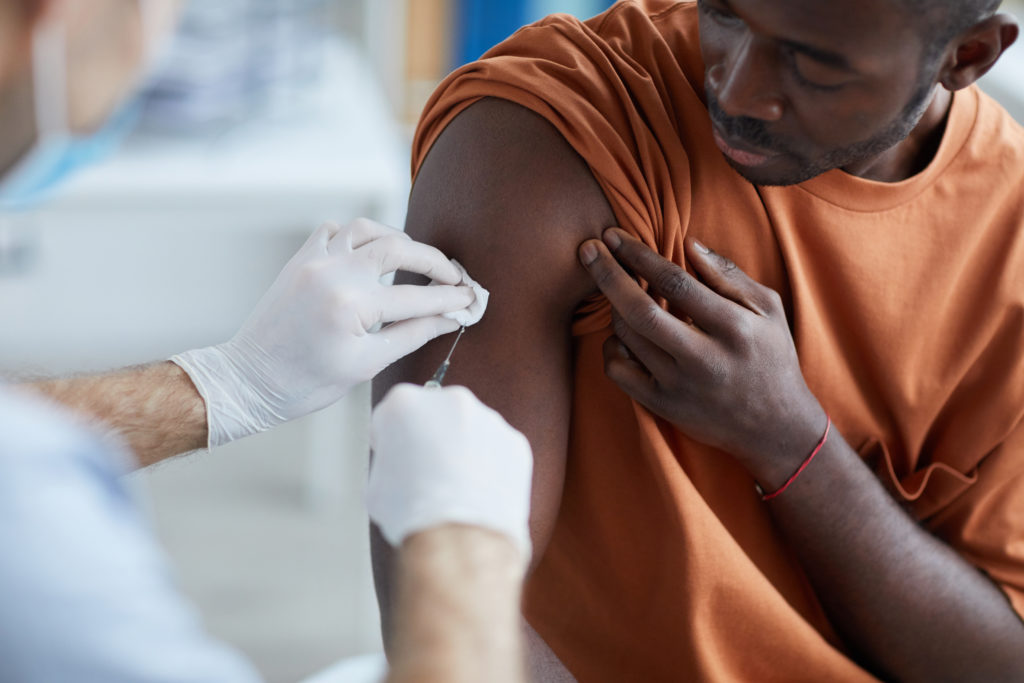In late February, Maine passed another grim COVID-19 milestone, with one in ten Black Mainers having tested positive for the virus. That’s more than three times the rate at which white Mainers have tested positive. Meanwhile, the state’s current vaccination schedule may be excluding many Black Mainers from the chance to be immunized early.
The rate of coronavirus infection among Black Mainers actually represents an improvement from the earliest days of the pandemic, when Black Mainers were more than twenty times as likely to test positive as their white peers. This disparity was at one point the worst of any state in the nation.
The current figures are still unacceptably high, reflecting the increased risks Black Mainers face as frontline workers, as well as other legacies of historic and systemic racism. In addition to the higher infection rate, Black Mainers also have a higher hospitalization rate than, and comparable death rate to, white Mainers. This is especially concerning because while age is one of the biggest risk factors for COVID-19 patients, Black Mainers are generally younger than the state as a whole. If one compared Black and white Mainers of a similar age, the disparities would likely be even larger. (Nationally, Black Americans have death rates equivalent to white Americans a decade older than themselves).
Vaccination schedule could make this worse
The rollout of vaccinations in Maine promises the beginning of the end of the Coronavirus pandemic. Yet Maine is at risk of exacerbating the racial disparities of the pandemic with the way it has chosen to allocate vaccines.
The underlying reason appears to be the way eligibility for the vaccine has been determined in Maine. Initially, the vaccine has been available only to health care workers, first responders, nursing home residents and staff. Mainers over the age of 70 have been eligible since mid-January, and Mainers over the age of 60 became eligible starting March 3rd. Because white Mainers are more likely to be older than Black Mainers, the emphasis on age in determining eligibility means that Black Mainers must wait longer for the vaccine despite their higher rates of infection and hospitalization. Under the current schedule, most white Maine adults will be eligible for the vaccine in April, but the majority of Black adults in Maine won’t be eligible until June.
Re-examining vaccination data with eligibility restrictions in mind shows that within the eligible population, Black Mainers are more likely to have been vaccinated than their white peers. In other words, it does not appear to be vaccine hesitancy or other barriers which is holding back the vaccination of the Black population, but the eligibility criteria. Despite higher vaccination rates among currently eligible Black Mainers, addressing racial disparities in overall vaccination rates would require a different approach.
Tribal efforts may provide a model
Maine must do more to ensure that Black Mainers, who are still disproportionately affected by COVID-19, have better access to the vaccine. One example it can draw upon is that set by Maine’s tribal communities. Three of Maine’s four tribes have elected to receive their allotment of vaccines directly from the federal government, rather than through the state. This has allowed tribal health centers to begin vaccinating community members independently, and to set their own guidelines.
So far, the data shows that the tribes’ approach has been effective. American Indians have the highest vaccination rate of any major racial or ethnic group in Maine. As of March 2, 9 percent of American Indians in Maine had received a second dose of the COVID-19 vaccine, substantially higher than the share of the white population.
Maine could take a similar approach to helping Black Mainers receive the vaccine quickly; equipping community organizations and health centers that primarily serve the Black population to administer vaccines.
The National Academy of Sciences has suggested prioritizing vaccine distribution in certain neighborhoods or regions where social and economic conditions suggest a higher vulnerability for contracting COVID-19. A tool known as the Covid-19 Community Vulnerability Index has been developed for this purpose. For either approach to be most effective, the state must also consider opening up eligibility beyond the current age-based approach.
Maine’s COVID experience, and in particular that of Black Mainers, highlights the importance of having affirmatively anti-racist policies in place if we are to address existing inequalities. While Maine’s age-based vaccination approach is race-neutral on its face, the demographics of Maine’s black population mean that it will fall short in addressing the racial disparities already laid bare by COVID-19.




